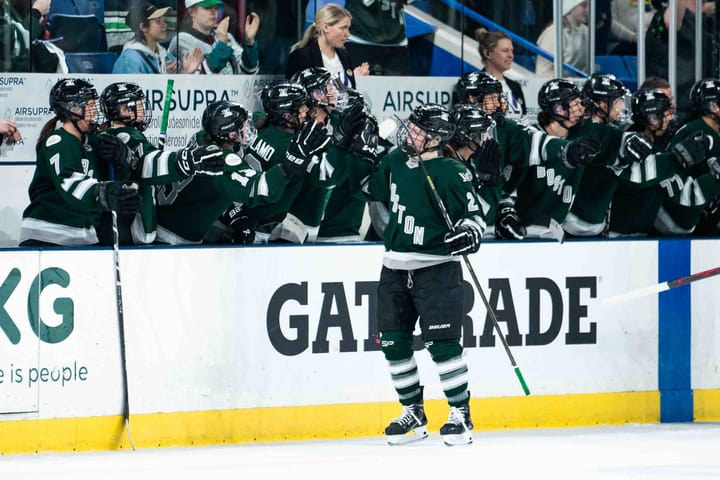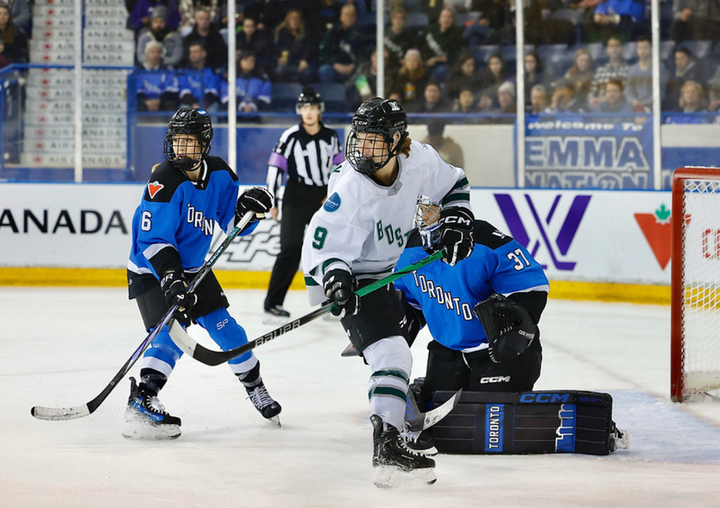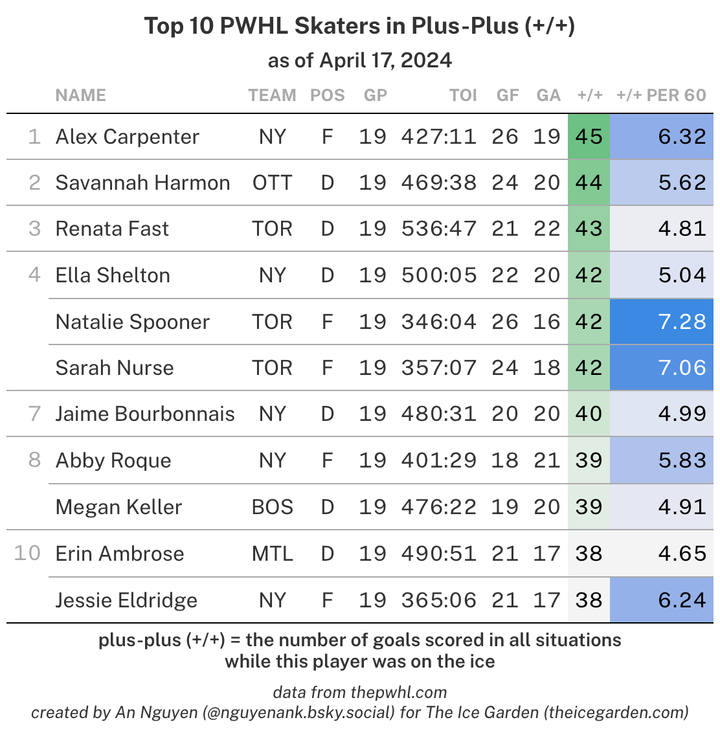Using Steady to identify shooting trends in the NWHL
Experimenting with applications for the shot metric Steady
Back in December, I introduced the NWHL-specific shot metric “Steady” (KSt) — appropriately named after NWHL great Kelley Steadman. Steady measures shots on goal as well as attempted shots that are blocked by the opposition.
KSt = shots on goal + shots blocked by the opposition
At first blush, Steady comes off as a quirky, less-useful cousin of Fenwick. But that doesn’t mean it can’t provide us with valuable insight and be a tool to analyze both players and teams.
By taking into consideration both shots on goal and shots that are blocked by players on opposing teams we can identify high volume shooters, observe team trends in shot attempts (excluding missed shots), and distinguish which shooters have the highest percentage of their shots blocked. That last point in particular should hold interest because it can be used as a rough measure of a player’s shooting efficiency, which has more nuance than shooting percentage. We can even use Steady as a rough guide to quantify puck possession (all situations). After all, you block shots when you are in your own zone.
To be clear, blocking shots is a valuable skill and an attribute we should turn to without hesitation when looking to identify defensive defenders and even defensive forwards, especially in the women’s game where data is scarce. But, all things considered, it is better to be attempting shots (especially quality ones) than trying to block them. If you want to win, you typically want the puck more than the opposition. On the other end of the ice, we’re trying to quantify what players stop from happening which makes it a bit more challenging. Blocks are one way to do that, though the value of every block obviously differs.
Team Level
The workbook below reveals a lot about shot share trends even if Steady excludes missed shots and we aren’t working with even strength shot attempts. It also lines up with where each team finished in the standings and, if we paint with broad strokes, what their overall team offenses and defenses were like.
Despite being shorthanded more often (9.04 PIM/GP) than the Whitecaps (7.08 PIM/GP), the Boston Pride topped in the league in both average 59.22 KStF/60 (Steady For per 60 minutes) and 36.76 KStA/60. That’s a +22.76 differential in Steady, which is why, on average, Boston out-scoring the opposition by over three goals a game in the 2019-20. One clear indicator of the Pride’s dominance this year is their average goal differential being nearly double the Connecticut Whale’s average goals per-game (1.58).
Clearly, the Whale had a rough go of things in the shot share battle. When Connecticut was in games, they were kept afloat by goaltending and a defense that was unafraid to block shots and managed to stay relatively disciplined despite struggling to dig themselves out of the d-zone. The Whale had a higher Steady than their opponents in just five of their 24 games and in two of those instances they barely edged out the Whitecaps.
The Beauts had a much smaller margin between their KStF/60 and KStA/60 than the Whale; -13.16 versus -18.96. However, they had the worst KStF60 (35.07) by a wide margin. So, why did they score so many more goals than Connecticut? The Beauts had a 19.23 percent success rate on the power play; the Whale were 7.61%. Buffalo’s over-dependence on the power play to produce offense put a lot of pressure on their goaltenders and they had the worst team save percentage in the league (.874). That did not make for smooth sailing for the Beauts.
Of course, any conclusions we can draw from perceived trends in Steady data is influenced by how stat-trackers counted the highly subjective real-time stat that is a blocked shot. The 24-game 2019-20 season helps the cause because of the size of the sample we are looking at, but it is something to keep in mind.
High-Volume Shooters
We can also use Steady to paint a clearer picture of who the league’s highest-volume shooters are. To add another layer, we can also factor what percentage of shot attempts a player is responsible for on their team relative to the team’s total Steady. This helps us level the playing field a bit and adjust for the dominant offenses of Boston and Minnesota.
The top-tier for high-volume shooters has a population of three: Nicole Schammel, Jillian Dempsey, and McKenna Brand. Dempsey and Brand were two-thirds of the best line in the NWHL, so there’s little surprise there, but Schammel definitely deserves more credit for her rookie season. She didn’t get nearly enough attention because, well, she’s not Allie Thunstrom, but her 7.63 KSt/GP suggests she spends a ton of time on the attack and isn’t afraid to fire away.
The second-tier consists of Thunstrom and rookie Kendall Cornine, who was a huge part of the Riveters’ offense as a heavy-shooting center. Interestingly enough, Kaleigh Fratkin and Sydney Baldwin led all defenders in KSt/GP, but no defender had a higher percentage of her team’s shot attempts than Shannon Doyle. Doyle, who played a staggering amount of minutes for the Whale in her own zone, managed to account for nearly 10 percent of Connecticut’s total shots on goal and shots that were blocked by rivals.
Shot Efficiency and Trends
Finally, let’s take a look at Steady and what it can potentially tell us about shot efficiency. By shot efficiency I’m referring to the percentage of shots a player gets on goal vs their attempted shots, excluding shots that miss the net. I struggled to think of the right word for this metric even though I think it has some potential considering how quirky it is.
ShEff% = SOG/KSt
Shot efficiency — or ShEff% for shorthanded — definitely has holes in it. The stat lacks desperately needed context for shot attempts and we would definitely be able to draw clearer conclusions if missed shots were also part of the equation. What do ShEff% trends look like on the power play vs. even strength play? Should we “penalize” a shooter for taking shots that are blocked? What about shots that are blocked by their teammates? At the moment, ShEff% is just a concept to play around with. I welcome any suggestions for how to improve it with data that is publicly available.
Looking at the ShEff% of NWHL defenders reveals that their shots are, generally speaking, blocked more often than forwards. This stands to reason. We can safely assume that, on average, defenders attempt more shots from greater distances than forwards. Big picture, shots taken from greater distances are more likely to collide with other players.
Defenders with a higher ShEff% could have more skill in getting shots through traffic and/or benefit from playing in an offense that creates more open shooting lanes for defenders. It could also be a marker of defenders who join the rush more often than their peers. At this stage, it’s hard to say and these numbers are obviously skewed by factors like power play ice time and team tactics. All of these are concepts that should be tested with robust tracking.
ShEff% could also tell us something about forwards. The league-wide average for ShEff% in 2019-20 was 79.17 percent, which is indicated in the interactive chart above with a line. The players who land above that average in the viz are among the most productive forwards in the league.
Thunstrom led the way with a 94.04% ShEff percentage. This is likely the result of her speed, playing with an elite playmaker like Jonna Curtis, and her own shot discipline and selection — although it’s hard to say how each of those factors shapes her ShEff%. The same can be said of Taylor Accursi, who was right on par with the league average in ShEff% but had a 23.2 Sh%. This makes her unsustainably high shooting percentage somehow even more remarkable. Which, again, calls for shot tracking and further analysis.
As is often the case when it comes to playing around with a new metric, we are left with plenty of questions and things to investigate. Now, it’s just a matter of adding more years of data and choosing which paths to take first. Of course, all of this would be simpler if we had comprehensive shot attempt data broken down by strength, but nothing is ever simple in women’s hockey analytics.
Steady and ShEff% are things to experiment with up to and potentially when/if we get shot attempt data for the NWHL on par with what we see in NHL analytics. After all, we still have a very poor understanding of things like puck possession and shot quality might differ between men’s and women’s hockey. The more we work with the data, the better we will understand the events, decisions, and skills that shape the outcome of shifts, periods, games, and seasons.
All data courtesy of NWHL.zone and the author’s own tracking. Data can be seen at herhockeycounts.com.





Comments ()